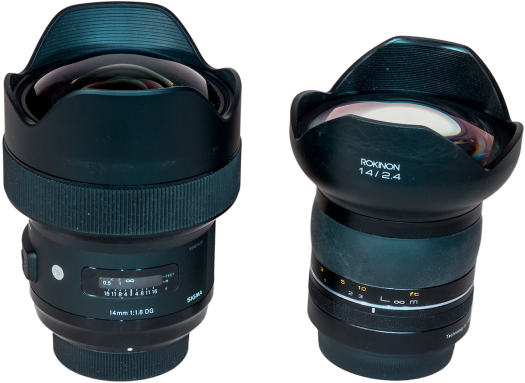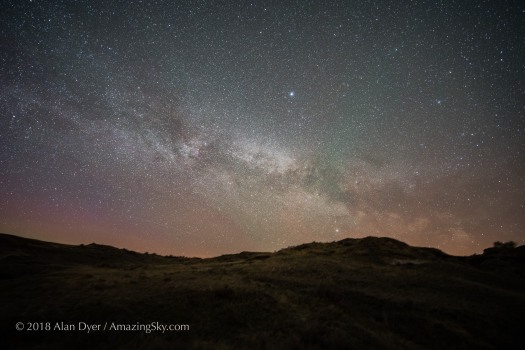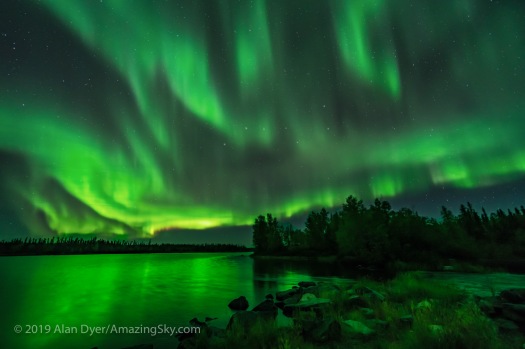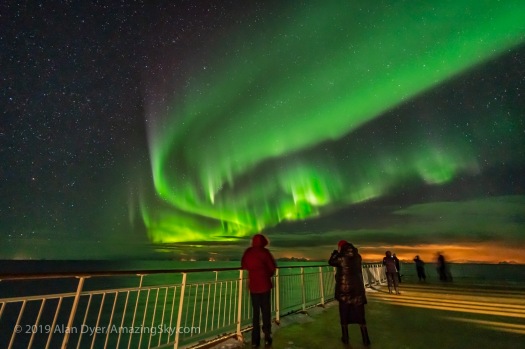
I test out a fast and very wide lens designed specifically for Sony mirrorless cameras.
In a previous test I presented results on how well the Sony a7III mirrorless camera performs for nightscape and deep-sky photography. It works very well indeed.
But what about lenses for the Sony? Here’s one ideal for astrophotography.
TL;DR Conclusions
Made for Sony e-mount cameras, the Venus Optics 15mm f/2 Laowa provides excellent on- and off-axis performance in a fast and compact lens ideal for nightscape, time-lapse, and wide-field tracked astrophotography with Sony mirrorless cameras. (UPDATE: Venus Optics has announced versions of this lens for Canon R and Nikon Z mount mirrorless cameras.)
I use it a lot and highly recommend it.
Size and Weight
While I often use the a7III with my Canon lenses by way of a Metabones adapter, the Sony really comes into its own when matched to a “native” lens made for the Sony e-mount. The selection of fast, wide lenses from Sony itself is limited, with the new Sony 24mm G-Master a popular favourite (I have yet to try it).
However, for much of my nightscape shooting, and certainly for auroras, I prefer lenses even wider than 24mm, and the faster the better.
 Aurora over Båtsfjord, Norway. This is a single 0.8-second exposure at f/2 with the 15mm Venus Optics lens and Sony a7III at ISO 1600.
Aurora over Båtsfjord, Norway. This is a single 0.8-second exposure at f/2 with the 15mm Venus Optics lens and Sony a7III at ISO 1600.
The Laowa 15mm f/2 from Venus Optics fills the bill very nicely, providing excellent speed in a compact lens. While wide, the Laowa is a rectilinear lens providing straight horizons even when aimed up, as shown above. This is not a fish-eye lens.
 Though a very wide lens, the 15mm Laowa accepts standard 72mm filters. The metal lens hood is removable. © 2019 Alan Dyer
Though a very wide lens, the 15mm Laowa accepts standard 72mm filters. The metal lens hood is removable. © 2019 Alan DyerThe Venus Optics 15mm realizes the potential of mirrorless cameras and their short flange distance that allows the design of fast, wide lenses without massive bulk.
 Sigma 14mm f/1.8 Art lens (for Nikon mount) vs. Venus Optics 15mm f/2 lens (for Sony mount). © 2019 Alan Dyer
Sigma 14mm f/1.8 Art lens (for Nikon mount) vs. Venus Optics 15mm f/2 lens (for Sony mount). © 2019 Alan DyerWhile compact, at 600 grams the Laowa 15mm is quite hefty for its size due to its solid metal construction. Nevertheless, it is half the weight of the massive 1250-gram Sigma 14mm f/1.8 Art. The Laowa is not a plastic entry-level lens, nor is it cheap, at $850 from U.S. sources.
For me, the Sony-Laowa combination is my first choice for a lightweight travel camera for overseas aurora trips
 The lens mount showing no electrical contacts to transfer lens metadata to the camera. © 2019 Alan Dyer
The lens mount showing no electrical contacts to transfer lens metadata to the camera. © 2019 Alan DyerHowever, this is a no-frills manual focus lens. Nor does it even transfer aperture data to the camera, which is a pity. There are no electrical connections between the lens and camera.
However, for nightscape work where all settings are adjusted manually, the Venus Optics 15mm works just fine. The key factor is how good are the optics. I’m happy to report that they are very good indeed.
Testing Under the Stars
To test the Venus Optics lens I shot “same night” images, all tracked, with the Sigma 14mm f/1.8 Art lens, at left, and the Rokinon 14mm SP (labeled as being f/2.4, at right). Both are much larger lenses, made for DSLRs, with bulbous front elements not able to accept filters. But they are both superb lenses. See my test report on these lenses published in 2018.
 The Sigma 14mm f/1.8 Art lens (left) vs. the Rokinon SP 14mm f/2.4. © 2019 Alan Dyer
The Sigma 14mm f/1.8 Art lens (left) vs. the Rokinon SP 14mm f/2.4. © 2019 Alan DyerThe next images show blow-ups of the same scene (the nightscape shown in full below, taken at Dinosaur Provincial Park, Alberta), and all taken on a tracker.
I used the Rokinon on the Sony a7III using the Metabones adapter which, unlike some brands of lens adapters, does not compromise the optical quality of the lens by shifting its focal position. But lacking a lens adapter for Nikon-to-Sony at the time of testing, I used the Nikon-mount Sigma lens on a Nikon D750, a DSLR camera with nearly identical sensor specs to the Sony.
Vignetting
 A tracked image with the Venus Optics Laowa 15mm at f/2. Click or tap on an image to download a full-resolution JPG for closer inspection.
A tracked image with the Venus Optics Laowa 15mm at f/2. Click or tap on an image to download a full-resolution JPG for closer inspection.Above is a tracked image (so the stars are not trailed, which would make it hard to tell aberrations from trails), taken wide open at f/2. No lens correction has been applied so the vignetting (the darkening of the frame corners) is as the lens provides.
As shown above, when used wide open at f/2 vignetting is significant, but not much more so than with competitive lenses with much larger lenses, as I compare below.
And the vignetting is correctable in processing. Adobe Camera Raw and Lightroom have this lens in their lens profile database. That’s not the case with current versions (as of April 2019) of other raw developers such as DxO PhotoLab, ON1 Photo RAW, and Raw Therapee where vignetting corrections have to be dialled in manually by eye.
 A tracked image with the Venus Optics Laowa 15mm stopped down 1 stop to f/2.8.
A tracked image with the Venus Optics Laowa 15mm stopped down 1 stop to f/2.8.When stopped down to f/2.8 the Laowa “flattens” out a lot for vignetting and uniformity of frame illumination. Corner aberrations also improve but are still present. I show those in close-up detail below.
 15mm Laowa vs. Rokinon 14mm SP vs. Sigma Art 14mm – Comparing the left side of the image for vignetting (light fall-off), wide open and stopped down. ©2018 Alan Dyer
15mm Laowa vs. Rokinon 14mm SP vs. Sigma Art 14mm – Comparing the left side of the image for vignetting (light fall-off), wide open and stopped down. ©2018 Alan DyerAbove, I compare the vignetting of the three lenses, both wide open and when stopped down. Wide open, all the lenses, even the Sigma and Rokinon despite their large front elements, show quite a bit of drop off in illumination at the corners.
The Rokinon SP actually seems to be the worst of the trio, showing some residual vignetting even at f/2.8, while it is reduced significantly in the Laowa and Sigma lenses. Oddly, the Rokinon SP, even though it is labeled as f/2.4, seemed to open to f/2.2, at least as indicated by the aperture metadata.
On-Axis Performance
 15mm Laowa vs. Rokinon 14mm SP vs. Sigma Art 14mm – Comparing the centre of the image for sharpness, wide open and stopped down. Click or tap on an image to download a full-resolution JPG for closer inspection. © 2018 Alan Dyer
15mm Laowa vs. Rokinon 14mm SP vs. Sigma Art 14mm – Comparing the centre of the image for sharpness, wide open and stopped down. Click or tap on an image to download a full-resolution JPG for closer inspection. © 2018 Alan DyerAbove I show lens sharpness on-axis, both wide open and stopped down, to check for spherical and chromatic aberrations with the bright blue star Vega centered. The red box in the Navigator window at top right indicates what portion of the frame I am showing, at 200% magnification in Photoshop.
On-axis, the Venus Optics 15mm shows stars just as sharply as the premium Sigma and Rokinon lenses, with no sign of blurring spherical aberration nor coloured haloes from chromatic aberration.
 This is where this lens reaches sharpest focus on stars, just shy of the Infinity mark. © 2019 Alan Dyer
This is where this lens reaches sharpest focus on stars, just shy of the Infinity mark. © 2019 Alan DyerFocusing is precise and easy to achieve with the Sony on Live View. My unit reaches sharpest focus on stars with the lens set just shy of the middle of the infinity symbol. This is consistent and allows me to preset focus just by dialing the focus ring, handy for shooting auroras at -35° C, when I prefer to minimize fussing with camera settings, thank you very much!
Off-Axis Performance
 15mm Laowa vs. Rokinon 14mm SP vs. Sigma Art 14mm – Comparing the centre of the image for sharpness, wide open and stopped down. Click or tap on an image to download a full-resolution JPG for closer inspection. © 2018 Alan Dyer
15mm Laowa vs. Rokinon 14mm SP vs. Sigma Art 14mm – Comparing the centre of the image for sharpness, wide open and stopped down. Click or tap on an image to download a full-resolution JPG for closer inspection. © 2018 Alan Dyer 15mm Laowa vs. Rokinon 14mm SP vs. Sigma Art 14mm – Comparing the upper right corner of the image for aberrations, wide open and stopped down. © 2018 Alan Dyer
15mm Laowa vs. Rokinon 14mm SP vs. Sigma Art 14mm – Comparing the upper right corner of the image for aberrations, wide open and stopped down. © 2018 Alan DyerThe Laowa and Sigma lenses show similar levels of off-axis coma and astigmatism, with the Laowa exhibiting slightly more lateral chromatic aberration than the Sigma. Both improve a lot when stopped down one stop, but aberrations are still present though to a lesser degree.
However, I find that the Laowa 15mm performs as well as the Sigma 14mm Art for star quality on- and off-axis. And that’s a high standard to match.
The Rokinon SP is the worst of the trio, showing significant elongation of off-axis star images (they look like lines aimed at the frame centre), likely due to astigmatism. With the 14mm SP, this aberration was still present at f/2.8, and was worse at the upper right corner than at the upper left corner, an indication to me that even the premium Rokinon SP lens exhibits slight lens de-centering, an issue users have often found with other Rokinon lenses.
Real-World Examples – The Milky Way
 This is a stack of 8 x 2-minute exposures with the Venus Optics Laowa 15mm lens at f/2 and Sony a7III at ISO 800, on the Sky-Watcher Star Adventurer tracker. A single exposure taken through the Kenko Softon A filter layered in with Lighten mode adds the star glows, though exaggerates the lens distortion on the bright stars.
This is a stack of 8 x 2-minute exposures with the Venus Optics Laowa 15mm lens at f/2 and Sony a7III at ISO 800, on the Sky-Watcher Star Adventurer tracker. A single exposure taken through the Kenko Softon A filter layered in with Lighten mode adds the star glows, though exaggerates the lens distortion on the bright stars. This is a stack of 12 exposures for the ground, mean combined to smooth noise, and one exposure for the sky, all 30 seconds at f/2 with the Laowa 15mm lens on the Sony a7III camera at ISO 6400. These were the last frames in a 340-frame time-lapse sequence.
This is a stack of 12 exposures for the ground, mean combined to smooth noise, and one exposure for the sky, all 30 seconds at f/2 with the Laowa 15mm lens on the Sony a7III camera at ISO 6400. These were the last frames in a 340-frame time-lapse sequence.The fast speed of the Laowa 15mm is ideal for shooting tracked wide-field images of the Milky Way, and untracked camera-on-tripod nightscapes and time-lapses of the Milky Way.
Image aberrations are very acceptable at f/2, a speed that allows shutter speed and ISO to be kept lower for minimal star trailing and noise while ensuring a well-exposed frame.
Real World Examples – Auroras
 Aurora over the Churchill Northern Studies Centre, Churchill, Manitoba. This is 6 seconds at f/2 with the 15mm Venus Optic lens and Sony a7III at ISO 3200.
Aurora over the Churchill Northern Studies Centre, Churchill, Manitoba. This is 6 seconds at f/2 with the 15mm Venus Optic lens and Sony a7III at ISO 3200. Aurora from near Yellowknife, NWT, September 8, 2018. This is 2.5-seconds at f/2 with the Venus Optics 15mm lens and Sony a7IIII at ISO 3200.
Aurora from near Yellowknife, NWT, September 8, 2018. This is 2.5-seconds at f/2 with the Venus Optics 15mm lens and Sony a7IIII at ISO 3200. The Northern Lights from at sea when leaving the Lofoten Islands, Norway heading toward the mainlaind, from Stamsund to Bodo, March 3, 2019. This was from the Hurtigruten ship the ms Trollfjord. This is a single 1-second exposure for at f/2 with the 15mm Venus Optics lens and Sony a7III at ISO 6400.
The Northern Lights from at sea when leaving the Lofoten Islands, Norway heading toward the mainlaind, from Stamsund to Bodo, March 3, 2019. This was from the Hurtigruten ship the ms Trollfjord. This is a single 1-second exposure for at f/2 with the 15mm Venus Optics lens and Sony a7III at ISO 6400.Where the Laowa 15mm really shines is for auroras. On my trips to chase the Northern Lights I often take nothing but the Sony-Laowa pair, to keep weight and size down.
Above is an example, taken from a moving ship off the coast of Norway. The fast f/2 speed (I wish it were even faster!) makes it possible to capture the Lights in only 1- or 2-second exposures, albeit at ISO 6400. But the fast shutter speed is needed for minimizing ship movement.
Video Links
The Sony also excels at real-time 4K video, able to shoot at ISO 12,800 to 51,200 without excessive noise.
Aurora Reflections from Alan Dyer on Vimeo. The Sky is Dancing from Alan Dyer on Vimeo. The Northern Lights At Sea from Alan Dyer on Vimeo.Examples of my aurora videos shot with the Sony and Venus Optics 15mm lens are in previous blogs from Yellowknife, NWT in September 2018, from Churchill, Manitoba in February 2019, and from at sea in Norway in March 2019.
Click through to see the posts and the videos shot with the Venus Optics 15mm.
As an aid to video use, the aperture ring of the Venus Optics 15mm can be “de-clicked” at the flick of a switch, allowing users to smoothly adjust the iris during shooting, avoiding audible clicks and jumps in brightness. That’s a very nice feature indeed.
In all, I can recommend the Venus Optics Laowa 15mm lens as a great match to Sony mirrorless cameras, for nightscape still and video shooting. UPDATE: Versions for Canon R and Nikon Z mount mirrorless cameras will now be available.
— Alan, April 20, 2019 / © 2019 Alan Dyer / AmazingSky.com


Thank you and great job on the review. I purchased the Laowa 15mm and like the results of my Milky Way shots. I got the same results as you did, even getting star points on Vega at 2.8, however I had to send it back for replacement for another reason.
I tested my replacement this morning and could not get the star points at 2.8 or even f/4. I even tried focusing on several spots near the infinity marker getting no star points. Also on the first lens the best focus point was just before the marker but I had heard the best spot was at the point you mentioned.
As I said I tried different spots and even tried focusing live with peaking on high and still the results were not as sharp as my first version. Unfortunately I may have to send this lens back as well.
I guess I could have a bad copy, and I’m hoping its not operator error. Otherwise I love this lens!
Alan: On your reply to Alyn Wallace (Apr. 27, 2019), I tested the Sony version of the Sigma 14/1.8 taking Milky Way shots just three weeks ago, and the images from it look exactly like your Nikon version. In fact, I almost “recognized” it from your line up of image slices!
Alan – Thank you for this detailed and pretty comprehensive write up. I think this is one of the most if not THE most useful comparative analysis of the three most likely candidate lenses for star photography as of mid-2019.
One thing I am curious about – if you are using a tracker, then why do you go to ISO 6400? Do you see any issues clamping down to a lower ISO, like 800 or even lower, and letting the exposure run really long with a Sony A7x?
If long exposures is not an issue, wouldn’t that bring other lenses into play, like a Zeiss 15/2.8 Distagon or Milvus, or even the Sony 12-24 f/4, although it does suffer from barrel distortion? Have you tried any other lenses for astro photography that you like?
Last question, have you tried using the Breakthrough Technology Night Sky filter that is designed to cut down the effects of light pollution?
TIA for any additional insights.
Best regards,
Roy
Thanks! I think I shot at 6400 for testing purposes just to keep exposure times down when shooting at the smaller apertures. To get as much shot as possible in a short time before sky conditions changed. I think! It was a year ago I shot those. And no, I have not tested those other lenses. Love to, but I don’t affiliate with lens suppliers to get stuff sent to me. I can buy only so many new lenses! I’ve only tried the NISI Natural Night filter and it works fine. Samples are in my ebook. I have another red enhancer filter on order so I might publish a test of it and the NISI at some point. There are many such filters. One company keeps promising to send me a popular one of theirs for testing but nothing ever arrives.
Nice review Alan thanks.
A little gutted you didn’t step the Sigma 14mm down to at least f/2.8 and compare shots with similar light transmission though. I find my Sigma pretty damn aberration free at f/2.8 and it would be interesting to see what aperture the laowa requires to have the same light transmission as the sigma at 2.8.
Do remember that this wasn’t a test of the Sigma but of the Laowa. I stopped down all lenses by a similar degree from their maximum apertures. For a more complete test of lenses see https://amazingsky.net/2017/09/22/the-fast-14s-face-off/
Even so, no matter how you test, someone will always say “You should have tested this or that, or used the lens on this camera or that.” Someone once claimed to me that the Nikon version of a lens would perform differently than the Canon version. I said, send me the evidence. I never heard from him again. It was all internet mythology.
Appreciate it wasn’t a test of the Sigma lens but given that they are in direct competition with each other being the only 2 super wide super fast lenses for Sony it just would have been nice to see how they competed against each other for equivalent t-stops rather than f-stops, as f/2 will not have equivalent light transmission on both lenses.
Not a complaint, just some CC, appreciate what you do.
Thanks! I’d love to re-test with Sigma vs Laowa but I’d really need the Sony emount version of the Sigma 14mm to be most accurate for transmission and I’m not about to spend that money! I do not test units sent by camera stores in return for marketing blogs.
My Sigma 14mm Art is for Nikon F and while I have two adapters for Nikon-to-Sony neither work well, either shifting the focus point and thus altering the lens aberration performance immensely, or being so manual with no electrical connection that adjusting the aperture is not allowed. It was a mistake buying either adapter!
So sticking my existing Sigma on the Sony wouldn’t work well for accurate testing.
Even so, I think the tests show that if you do want to the best on the Sony the Sigma is likely the way to go as it does have less vignetting – it better have with such a massive amount of glass. But the Laowa comes very close and at half the weight and price. So you decide!
And in future with mirrorless cameras I think we really want to see more such lenses as the Laowa, ones designed to take advantage of the shallow flange distance of the body, and not be just remounted and repackaged units originally made for DSLRs. Sigma and others need to rework their designs to be native for the Nikon Z, Canon R, and Sony alphas. Then, we can make a true comparison. Cheers! Clear skies!
Thank you for your excellent review, the Laowa 15mm f/2 lens paired with the Sony A7 III looks like a great combo for landscape astrophotography!